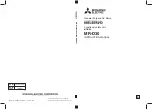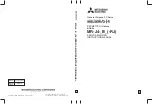
62
YASKAWA
|
YASKAWA AC Drive
CR700
Catalog
|
KAEP C710617 24
■
Wiring on UL- and cUL-certifi ed drives
When performing wiring work on UL/cUL-certifi ed drives,
wire the drives at their recommended tightening torques
using UL/cUL-compliant wires. For drives that require
connection with closed-loop crimp terminals, use closed-
loop crimp terminals and perform closed-loop crimping
work using the crimping tools specifi ed by the terminal
manufacturer.
■
Replacing an existing model
・
Wires used in existing models may be out of connection
range. Contact Yaskawa beforehand for the available
wire gauges.
・
If replacing an existing model with drives with catalog
codes of CR
70
□
2180 and lower or 4150 and lower, the
wire connection method should be changed. Cut off the
crimp terminal and remove the covering to expose the
wires. If an uninsulated wire is already connected to it,
check the condition of the tip of the wire. After peeling of
the dressing as necessary, wire again.
■
Transporting the Drive
Never steam clean the drive. During transport, keep the
drive from coming into contact with salts, fl uorine,
bromine and other such harmful chemicals.
Storage
The drive contains electrolytic capacitors and fi ne electronic
components that undergo chemical changes. Observe the
following precautions to help maintain the expected
performance life and reliability during long-term storage.
■
Storage Location
・
T emperature and humidity
Storage temperatures between -20 to
+
70 C are
allowed when storing the drive for approximately one
month. During transport, store and pack the drive so
that it is isolated from as much vibration and shock as
possible. Store the drive in a location with a relative
humidity of
95% or less. Do not store the drive in direct
sunlight or where condensation or ice will form.
・
Dust and oil mist
Do not store the drive in dusty locations or locations that
are susceptible to oil mist, such as the site of a cement
factory or cotton mill.
・
Corrosive gas
Do not store the drive in an area that may contain
corrosive gas or in a location like a chemical plant,
refi nery, or sewage facility.
・
Salt-air damage
Do not store the drive in locations that are subject to salt
damage, such as near the ocean, and salt damage-
designated zones, in particular.
Do not store the drive in adverse environments. Store all
drives in storage rooms that are not subjected to adverse
environmental elements.
■
Periodic Power Application
Try to apply power to the drive once per year for at least
30 minutes to prevent the capacitors from deteriorating.
When applying power after power has not been applied
for more than two years, Yaskawa recommends using a
variable power source and gradually increasing the power
over a period of
2 to 3 minutes. Apply power for at least 1
hour with no load to age the main circuit electrolytic
capacitor.
Wire the drive normally and check for drive faults,
overcurrents, motor vibration, speed fl uctuations, and
other abnormalities during operation after performing the
above procedure.
■
Environmental Specifi cations
The drive must not be used in the above mentioned
environments. However, if it is diffi cult to avoid running the
drive in these environments, Yaskawa offers special drives
that are resistant to moisture, gas, vibrations, and salt.
Contact Yaskawa for details.
Be aware that drives with these specifi cations do not
guarantee complete protection for the environmental
conditions indicated.
■
Contact Yaskawa when running an isolation test with a
drive.
Application Notes
(continued)







































